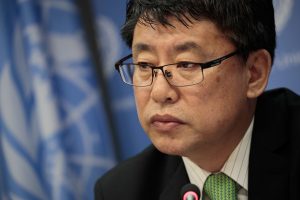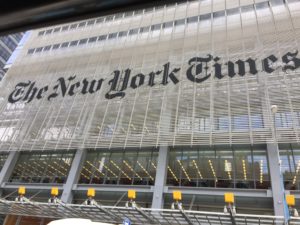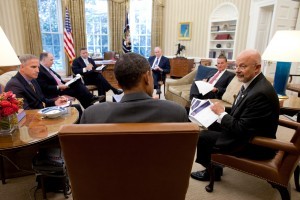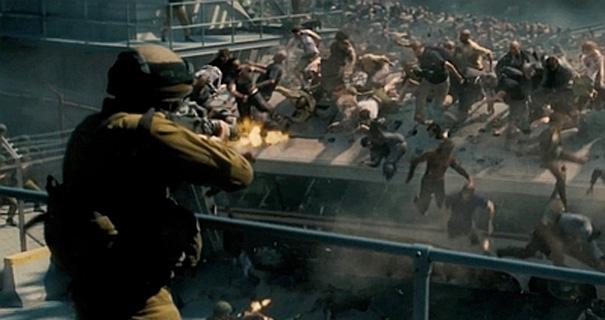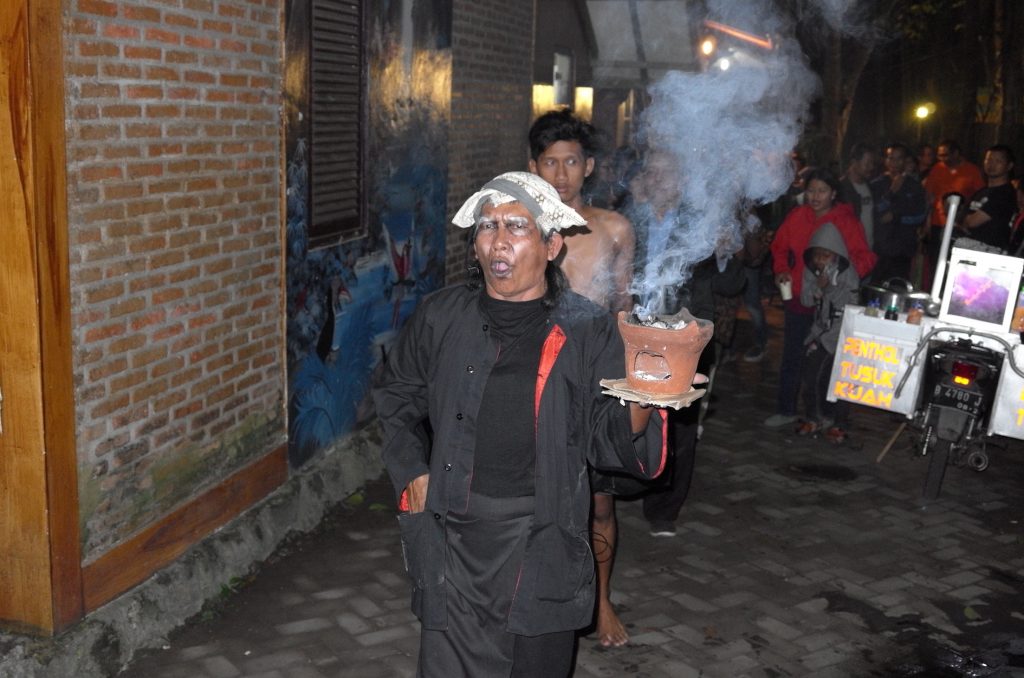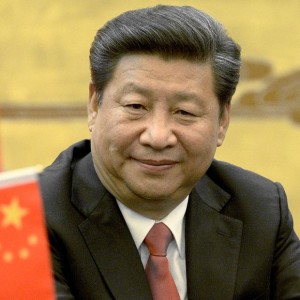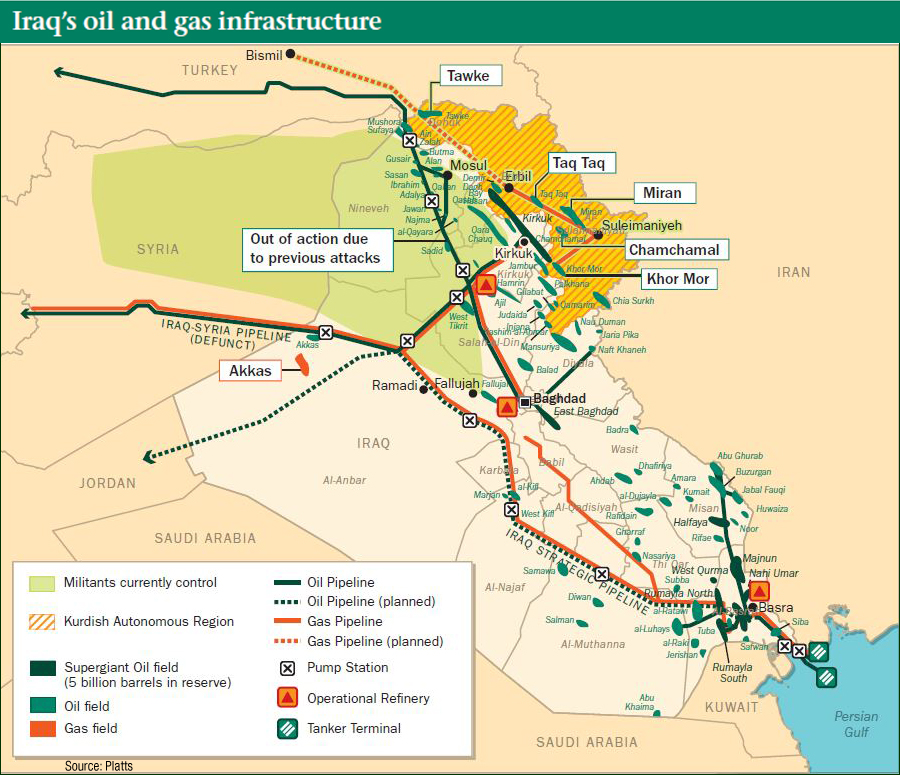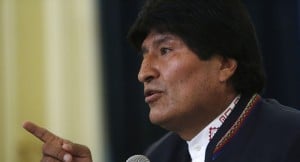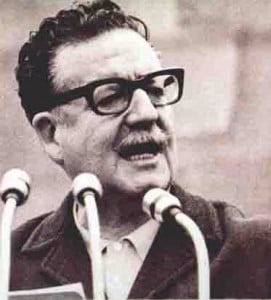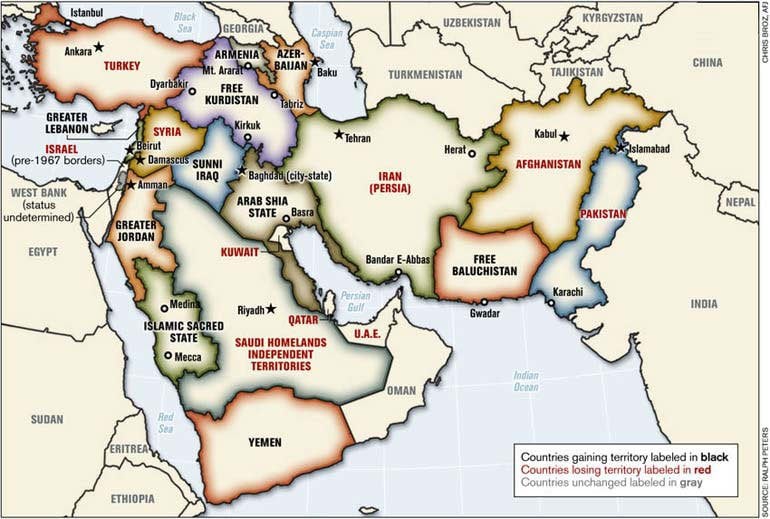Ever since Hurricane Maria and Irma devastated Puerto Rico, a looming question has been what will happen to the island’s $74.8 billion in debt, which had crippled its economy even before the storms hit. Protesters in major U.S. cities on October 3 called for the U.S. government to forgive the debt. Market analysts say repayment is unrealistic now that the island has suffered an estimated $45 billion to $95 billion in hurricane damage.
“They owe a lot of money to your friends on Wall Street, and we’re going to have to wipe that out,” President Donald Trump said on Fox News after a quick stop in Puerto Rico. The following day, the director of the White House budget office, Mick Mulvaney, reversed course, saying:
“I think what you heard the president say is that Puerto Rico is going to have to figure out a way to solve its debt problem.”
A legal battle over that debt has been playing out in bankruptcy court since May, and none of the mutual funds, hedge funds, creditors and bond insurers fighting for their share has indicated they will relinquish their claims.
But who are these bondholders, exactly? Their identities have been largely a mystery: There’s no complete public listing of their names or the amounts of debt they claim.
Public information access in Puerto Rico is a struggle. Public officials often refuse to fulfill requests, and the Government Development Bank (GDB) of Puerto Rico has kept information about the island’s bondholders close to the vest. The GDB did not even fulfill a request for the names from a governor-appointed auditing commission in June 2016.
The Centro de Periodismo Investigativo went to court in July 2015 to challenge the GDB’s claim that creditor information was confidential and private. After a lengthy appeal process, we obtained the identities of 275 firms that purchased bonds in the Puerto Rican government’s junk bond sale in 2014, the largest such sale in U.S. history. Many of these bonds, however, have since changed hands.
Over the past several months, after a review of court filings, documents from financial firms, government bond issues, off the record interviews, press clippings, FINRA, Puerto Rico’s Office of the Commissioner of Insurance, Open Secrets, LinkedIn and other social media sources, and U.S. Securities and Exchange Commission (SEC) filings, we have put together the most up-to-date list of the owners of Puerto Rico’s debt, naming dozens of bondholders and providing dossiers on their backgrounds.
Overall, we have identified more than 30 hedge and mutual funds, insurers and financial institutions that collectively claim billions of dollars in Puerto Rico’s debt.
The popular narrative of Puerto Rico’s debt holders is that they are “small” individual bondholders—rookie investors who trusted their savings to financial firms. But our investigation reveals that some of the most aggressive players demanding debt repayment in Puerto Rico’s bankruptcy court are so-called “vulture firms.” These hedge funds specialize in high-risk “troubled assets” near default or bankruptcy and cater to millionaire and billionaire investors.
VULTURES CIRCLE THE ISLAND
When Puerto Rico declared a form of bankruptcy in May, it was the largest municipal bankruptcy debt in U.S. history. Puerto Rico’s more than $74.8 billion in debt and $49 billion in pension system obligations surpasses Detroit, Mich.’s $18 billion bankruptcy in 2013. Much of that debt is interest. According to a report by the ReFund America Project, the financial firms like Goldman Sachs and Citigroup that helped structure the bonds built in astronomically high interest rates. Nearly half the debt—$33.5 billion—is interest, and another $1.6 billion comes from fees paid to these firms.
To scrounge up that money, Puerto Rico has been struggling through austerity measures approved last spring by a U.S.-appointed fiscal control board, including school closures and utility bill hikes. In August the control board proposed even more draconian measures, such as massive furloughs.
Then the hurricanes hit. Much of Puerto Rico still lacks access to water, electricity and basic services. As of October 11, 5,037 people (and 82 pets) were living in shelters, 50 percent of banks were closed, 59 percent of land lines and 43 percent of cell towers were down, and 86 percent of the island lacked power. Moody’s estimates that rebuilding will cost between $45 billion and $95 billion.
The fiscal control board has released $1 billion for hurricane relief. According to Gov. Ricardo Rossello, only $2 billion is left in the Treasury Department’s account. The government warns that it may run out of money by the end of the month.
The bankruptcy proceedings have been postponed while the island recovers from the hurricane. But while most of the island has been offline, lawyers for the bondholders have not stopped digitally submitting motions in the bankruptcy case.
The financial firms have organized themselves into alliances to aid their quest to get paid. These alliances include the Mutual Fund Group, which claims $7.1 billion in Puerto Rico’s debt; the Ad Hoc Group, which claims $3.3 billion; the Cofina Senior Bondholders Coalition, which claims $3.1 billion; ERS Secured Creditors, which claims roughly $1.4 billion; and the QTCB Noteholder Group, which claims more than $600 million.
The alliances can afford to hire prestigious law firms, like Jones Day, to file motions in Puerto Rico’s bankruptcy case on their behalf. And with the exception of the Mutual Fund Group, these big alliances are dominated by vulture funds.
For example, while the Cofina Senior Bondholders Coalition says it represents individual and retired bondholders, it is in fact controlled by vulture funds such as Canyon Partners, GoldenTree Asset Management and Tilden Park Capital Management, which require its clients to invest a minimum of $1 million to $5 million. Of the more than 30 known financial firms vying for Puerto Rico’s debt repayments, at least 24 are vulture firms.

THE TOP 10 VULTURES
Here are the top 10 vulture firms involved the bankruptcy case, listed in order of the amount of debt they’ve claimed in court We have compiled their names, addresses, and a bit of history on their business dealings.
#1 AUTONOMY CAPITAL
Puerto Rican Debt Claimed in Court: $937,585,000
Headquarters: 90 Park Ave., 31st Floor, New York, N.Y., 10016 and Floor 2, Conway House, Conway Street, St. Helier, Jersey
Part of an Alliance: Ad Hoc Group ($3.3 billion)
Type of Bond: General Obligation Bonds
Key People: Robert Gibbins, Derek Goodman
History: Autonomy Capital is an affiliate of Autonomy Americas, which is incorporated in the tax haven of the Channel Islands in the English Channel and claims to manage more than $4 billion.
Autonomy’s clients include insurance companies, foundations, public and private pension systems, and high net worth individuals. The minimum amount required to invest in Autonomy’s funds is between $5 million and $10 million.
Autonomy Capital is one of two firms involved in an ongoing legal battlewith the European Free Trade Association Surveillance Authority, a European watchdog, over millions of dollars worth of assets locked behind Iceland’s capital controls. Iceland, one of the only countries to aggressively regulate banks in the wake of the global financial crisis, instituted the controls after its biggest banks collapsed in 2008.
#2 DECAGON HOLDINGS / THE BAUPOST GROUP
Puerto Rican Debt Claimed in Court: $912,479,194
Headquarters: 10 Saint James Avenue, Suite 1700, Boston, Mass., 02116 (Decagon is registered in Delaware)
Part of an Alliance: Cofina Senior Bondholders Coalition ($3.1 billion)
Type of Bond: Puerto Rican Sales Tax Revenue Bonds
Key People: Seth Klarman
History:Decagon Holdings is a firm within the Cofina Senior Bondholders Coalition and owns at least 29 percent of this alliance’s debt—as much as $912,479,194—split among 10 funds, according to court documents.
The paper trail on Decagon is circuitous. These funds were incorporated in Delaware in 2015 as limited liability companies. Decagon is not registered at the Securities and Exchange Commission (SEC), the financial industry’s federal regulator, and it does not have a website.
In a document related to the Puerto Rico government’s bankruptcy case, Decagon Holdings only provided a general address, with no phone number: 800 Boylston Street, the location of the Prudential Tower, Boston’s second tallest building, with 52 floors.
On October 3, David Dayen of The Intercept unmasked Decagon Holdings’ real owner: The Baupost Group, a hedge fund that managed roughly $31.5 billion in regulatory assets as of December 31, 2016.
#3 CANYON CAPITAL ADVISORS LLC
Puerto Rican Debt Claimed in Court: $624,871,695
Headquarters: 2000 Avenue of the Stars, 11th Floor, Los Angeles, Calif., 90067
Part of an Alliance: Cofina Senior Bondholders Coalition ($303,080,000) and QTCB Noteholders Group ($321,791,695)
Type of Bond: Cofina or Sales Tax Senior Bonds and General Obligation Bonds (Issued by the Public Buildings Authority)
Key People: Joshua S. Friedman, Mitchell R. Julis, John Plaga, Jonathan Matthew Kaplan, Dominique Mielle
History: Canyon Capital Advisors LLC was founded in 1990 by Joshua S. Friedman and Mitchell R. Julis, both of whom have been intimately involved in stressed and distressed markets since the early 1980’s, according to information from the SEC.
As of 2016, Canyon employed “over 200 investment professionals” and had offices in Los Angeles, New York, London, Shanghai and Tokyo. The firm advertises itself as having “substantial experience with distressed financials, including liquidations and recapitalizations.”
In 2014, Canyon was one of the hedge funds that jumped on Puerto Rico’s junk bond emission, and requested $50 million of those bonds. It got $28 million.
#4 MONARCH ALTERNATIVE CAPITAL
Puerto Rican Debt Claimed in Court: $606,600,000
Headquarters: 535 Madison Ave., New York, N.Y., 10022 & 52 Conduit St., 6th Floor, London, England W1S 2YX, U.K.
Part of an Alliance: Ad Hoc Group ($3.3 billion)
Type of Bond: General Obligation Bonds
Key People: Michael Weinstock, Andrew Herenstein and Chris Santana
History: Monarch Alternative Capital has a history of investing in coal power. In February 2017, it became the principal shareholder in Arch Coal, the second largest supplier of coal to power companies in the U.S. The hedge fund owns $190 million (nearly 11 percent of the company). Arch Coal has been accused by United Mine Workers of America of conspiring with Peabody Energy in a scheme to default on $1.3 billion in retiree pension and healthcare obligations.
Monarch Alternative’s team includes former members of JP Morgan and Rothschild & Co, Stone Lion Capital, GoldenTree Asset Management, Davidson Kempner and Och-Ziff Capital.
Founded in 2002 by Michael Weinstock, Andrew Herenstein and Chris Santana, former bankers at Lazard Frères & Co., as of June 30 Monarch managed approximately $4.6 billion and had 63 employees, including 20 investment managers in offices in New York and London.
In 2015, Monarch bought $30 million in Four Seasons Health Care properties, the largest nursing home operator in Great Britain, which was carrying significant debt. In 2006, Monarch bought Oneida Limited, one of the world’s largest designers and sellers of stainless steel items, after that company went into Chapter 11 bankruptcy.
#5 GOLDENTREE ASSET MANAGEMENT
Puerto Rican Debt Claimed in Court: $587,253,141
Headquarters: 300 Park Ave., 21st Floor, New York, N.Y., 10022
Part of an Alliance: Cofina Senior Bondholders Coalition ($3.1 billion)
Type of Bond: Puerto Rican Sales Tax Revenue Bonds
Key People: Steve Shapiro
History: It is very common for vulture fund executives to be former bankruptcy attorneys, as is the case with Steve Shapiro, the executive director of GoldenTree Asset Management. He was a bankruptcy lawyerfor Stroock & Stroock & Lavan, where he represented bondholder committees and reorganized companies in Chapter 11 proceedings and out-of-court restructurings.
At the 2015 Milken Institute Global Conference (an annual gathering of billionaires and global finance power players that cost $50,000 a head in 2017), Shapiro spoke on a panel titled “Trash or Treasure? Finding Value in Distressed-Debt.” He said his firm had its eye on General Motors’ liquidation and found “parts of Puerto Rico…very interesting.” He mentioned the Puerto Rico Electric Power Authority (PREPA), the government-owned corporation that is the sole provider of electricity to the island. PREPA was already mired in debt, leading to serious maintenance problems. When the hurricane hit, that degraded infrastructure was wiped out, causing 88.3 percent of people on the island to still be without electricity as of October 10, according to the U.S. Department of Energy.
GoldenTree has not disclosed whether it currently owns PREPA bonds.
#6 AURELIUS CAPITAL MANAGEMENT LP
Puerto Rican Debt Claimed in Court: $473,417,000
Headquarters: 535 Madison Ave., 22nd Floor, New York, N.Y., 10022
Part of an Alliance: Ad Hoc Group ($3.3 billion)
Type of Bond: General Obligation Bonds, Puerto Rico Highways and Transportation Authority Bonds
Key People: Mark Brodsky, Samuel Jed Rubin, Esq., Eleazer Klein, Esq., and Jason Kaplan, Esq.
History: Mark Brodsky, founder and manager of Aurelius Capital, is another former bankruptcy lawyer, who for 16 years worked in major law firms in New York.
Much of that time, in the early 1990s, he served as an attorney and co-head of the bankruptcy practice at Kramer, Levin, Naftalis & Frankel. (The firm went on to represent bondholders Franklin Mutual and Oppenheimer Funds in a successful challenge to Puerto Rico’s 2015 Recovery Act, which would have allowed the island’s electric authority (PREPA), sewer authority and transportation authority to restructure their own debt.)
From 1996 to 2005, Brodsky was a partner in Elliott Management Corporation, a vulture fund owned by financial tycoon Paul Singer, who fought alongside Aurelius and other firms for the collection of Argentine debt.
Brodsky founded Aurelius in 2006 with $325 million in capital, of which more than half came from pension funds and foundations. Aurelius Capital has $4.83 billion in funds under management and focuses on investing in high-risk debt.
Aurelius has successfully profited from debt restructurings more than once. In Greece in 2012, in the midst of the European country’s financial turmoil, the government had to face what was described as a “small well-funded group of investors” who opposed a 75 percent haircut. Aurelius Capital was part of that group. In Brazil’s Petrobras, Aurelius forced a $54 billion default as a “precautionary measure.” The firm also attempted to upset a Tribune Co. bankruptcy plan in Chicago, Ill. that had been approved by most creditors; but in that attempt, they failed.
#7 TILDEN PARK INVESTMENT MASTER FUND LP
Puerto Rican Debt Claimed in Court: $466,084,719
Headquarters: 452 Fifth Ave., 28th Floor, New York, N.Y., 10018
Part of an Alliance: Cofina Senior Bondholders Coalition ($3.1 billion)
Type of Bond: Puerto Rican Sales Tax Revenue Bonds
Key People: Josh Birnbaum, Jeremy Primer, Sam Alcoff, Robert Rossitto
History:One of the biggest players—and biggest profiteers—in the U.S. financial crisis was Joshua Birnbaum, former managing director at Goldman Sachs and now chief investment officer of Tilden Park Capital Management. During this 15 years working at Goldman Sachs, he led transactions related to subprime mortgages that catalyzed the Great Recession.
After the real estate bubble collapsed, Birnbaum received one of the highest payments in Wall Street history, raking in $17 million in compensation. In his 2007 performance self-evaluations Birnbaum discussed the “very profitable year” and “extraordinary profits” that came from shorting the mortgage market that year, according to the SEC.
Birnbaum left Goldman Sachs in 2008 after he wasn’t named partner, raising much speculation. “The question is really, ‘What’s his encore?’ ” asked Geoff Bobroff, an asset management consultant, in an interviewwith The Telegraph.
The answer was Tilden Park Capital Management, which Birnbaum cofounded with fellow Goldman strategist (and Morgan Stanley alum) Jeremy Primer. Tilden Park handles more than $16 billion in assets.
The law firm of Paul Weiss Rifkind Wharton & Garrison, which represents the Ad Hoc Group of General Obligation Bondholders in the Title III case, was in turn the legal agent for several Tilden Park transactions, including one of $1,479,825,500 conducted in January.
#8 FUNDAMENTAL ADVISORS LP
Puerto Rican Debt Claimed in Court: $432,140,000
Headquarters: 745 Fifth Ave., 25th Floor, New York, N.Y., 10151
Part of an Alliance: Ad Hoc Group ($3.3 billion)
Type of Bond: General Obligation Bonds, Puerto Rican Sales Tax Revenue Bonds
Key People: Laurence L. Gottlieb, Hector Negroni, Dana S. Fusaris, Justin Vinci, Robyn A. Huffman and Bruce Kayle
History: Fundamental Credit Opportunities (FCO), a division of Fundamental Advisors, focuses on high-risk investments in states and cities under “financial pressure.”
FCO CEO Héctor Negroni was one of three executives of firms holding Puerto Rican debt who attended a panel at Ravitch Fiscal Reporting Program hosted by the Graduate School of Journalism at the City University of New York in June. Their presence was surprising, as the event was geared toward to journalists covering state and local fiscal issues, and executives from financial firms tend to shy away from media.
During the panel, Negroni wore a vest with the FCO Advisors logo on top of his checkered shirt. Sitting in a back row of the room, he listened to the other lecturers, and when he did not agree, he raised his voice to speak sharply over the speaker. He argued that commonwealth of Puerto Rico “is completely solvent. There’s no reason to be in default, no reason to be in bankruptcy.” (Negroni also took advantage of an pause before the panel to take to the microphone and sing a song, Frank Sinatra-style.)
#9 OAKTREE CAPITAL MANAGEMENT
Puerto Rican Debt Claimed in Court: $410,216,768
Headquarters: 333 S. Grand Ave., Los Angeles, Calif., 90071
Part of an Alliance: ERS Secured Creditors ($1.4 billion)
Type of Bond: Employee Retirement System Bonds
Key People: Howard Marks, Bruce Karsh, Jay Wintrob, John Frank, Sheldon Stone
History: Oaktree Capital Management is an investment firm that manages $100 billion through various hedge funds. It has 900 employees and offices in 17 cities, including London, Dubai, Hong Kong, Tokyo and Sydney. Oaktree’s clients include 75 of the 100 largest U.S. pension plans and 50 primary retirement plans, more than 400 corporations around the world and more than 350 foundations.
Oaktree has major interests in infrastructure, real estate and energy. Its energy holdings add up to $2 billion and it holds a “controlling position” in more than 15 companies in that sector.
In 2013, Oaktree Capital purchased 50 percent of Aerostar Airport Holdings, the operator of the Luis Munoz Marin International Airport San Juan. In May 2017, it sold its stake in Aerostar for $430 million to Grupo Aeroportuario del Sureste and the Canada’s Public Sector Pension Investment Board.
The firm also purchased $25 million in Puerto Rico’s 2014 General Obligations junk bond issue.
In Puerto Rico’s bankruptcy case, Oaktree Capital claims $410,216,768 in Retirement System bonds through seven funds : Oaktree Funds Opportunities Fund Holdings LP, Oaktree Opportunities Fund IX Delaware LP, Oaktree Opportunities Fund IX (Parallel 2) LP, Opps Culebra Holdings LP, Oaktree Opportunities Fund X Holdings (Delaware) LP, Oaktree Opps X Holdo Ltd and Oaktree-Forrest Multi-Strategy, LLC.
#10 STONE LION CAPITAL
Estimate of Puerto Rican Debt Owned: $325,377,000
Headquarters: New York, N.Y., U.S.
Part of an Alliance: Ad Hoc Group ($3.3 billion)
Type of Bond: General Obligation Bonds, Puerto Rico Highways and Transportation Authority Bonds
Key People: Gregory Augustine Hanley, Alan Jay Mintz, Danielle Schaefer Klyap, Claudia Lee Borg, Elan Daniels
History:Stone Lion Capital was founded by Alan Jay Mintz and Gregory Augustine Hanley in 2008. These two men were once risky debt dealers at Bear Stearns, the bank that infected the financial market with toxic mortgage assets, received a bailout from the Federal Reserve Bank and was later sold to JP Morgan.
In 2014, they requested $100 million from the Puerto Rico government’s junk bond issue and received $30 million. However, the firm is claiming, in total, more than $300 million in General Obligation bonds that may have been obtained before or after 2014. It also owns more than $15 million in bonds from Puerto Rico Highways and Transportation Authority.
Eric Michael Friel, senior managing director of Stone Lion Capital, was among the executives who attended the Ravitch event in New York this year. He was formerly a managing director and “risky debt” analyst at Bear Stearns & Co., one of the first banks to collapse in 2008.
“Contrary to popular belief, I believe investors like hedge funds want many of the same things that the people of Puerto Rico want,” he said at the Ravitch event, citing government transparency and Medicaid funding as examples. Noting that his father was a teacher, he added, “I understand the value of a good education, and that’s the last thing we want to see taken away from the people of Puerto Rico.”
However, the alliance of which Stone Lion is a member, the Ad Hoc Group, launched an offensive against the Puerto Rican health and education systems with a report commissioned in 2015 mapping a debt repayment plan. The report, “For Puerto Rico, There is a Better Way,” recommended the dismissal of teachers, cuts in the subsidy granted to the University of Puerto Rico and trims to “excess Medicaid benefits,” among other austerity measures.
At the Ravitch event, Friel spoke to press about the need for more transparency from the fiscal control board and the government of Puerto Rico. When CPI asked Friel to disclose the price at which Stone Lion Capital purchased Puerto Rican junk bonds in 2014, he said, “I don’t know the answer, and I think that’s the wrong thing to focus on. I think knowing that isn’t going to solve any of Puerto Rico’s problems. Literally. It’s not going to help anyone with anything.”
Note: One of the top ten debtholders, SV Capital, a member of the ERS alliance that claims $389,851,034 in debt, is omitted from this list because we could not determine whether it was a vulture firm. The company is a phantom—it was registered as an anonymous firm in Delaware on August 2016 and is not registered with the SEC. We learned it may be related to the Carlyle Group.
THE REST OF THE DEBT
This is necessarily an incomplete list. The alliances, although they are the loudest voices in the proceedings, represent only about 21 percent of the total debt.
Who are the missing players, and how much do they own? More transparency is urgently needed.
We will continue to follow the bankruptcy filings and post more information as it comes to light.
We will also be reporting on another group of debtholders: mutual funds.
Although most of the alliances are dominated by vultures, one, the Mutual Fund Group, is made up exclusively of three mutual funds: Franklin Mutual Advisors, Oppenheimer Funds and Santander Asset Management. Another powerful voice in bankruptcy court is the multinational investment firm UBS, which invested in mutual funds called Puerto Rico Family of Funds. UBS did not join an alliance, but has filed independent court briefs and claims $1.4 billion of the debt.
Mutual funds theoretically represent the interests of small-dollar investors, but many of those involved in Puerto Rico, including UBS and Oppenheimer, have a long trail of fraud claims and lawsuits filed by those investors. We’ll dive into that next.
A version of this story is available in Spanish on the CPIPR website.
Laura Moscoso and Ethan Corey contributed research and fact-checking.
Joel Cintron Arbasetti is a journalist at the Centro de Periodismo Investigativo (CPIPR). His work has appeared in Diálogo, Cruce Magazine and 80grados.net. He tweets at @JCArbasetti.
Carla Minet is a journalist and editor at CPIPR. Her work has appeared on Channel 6, Radio Universidad, El Nuevo Día, The New York Times, The Washington Post, Univision and Noticel. She tweets at @carlaminetpr.
Alex V. Hernandez is an assistant editor at In These Times.
Jessica Stites is executive editor of In These Times.
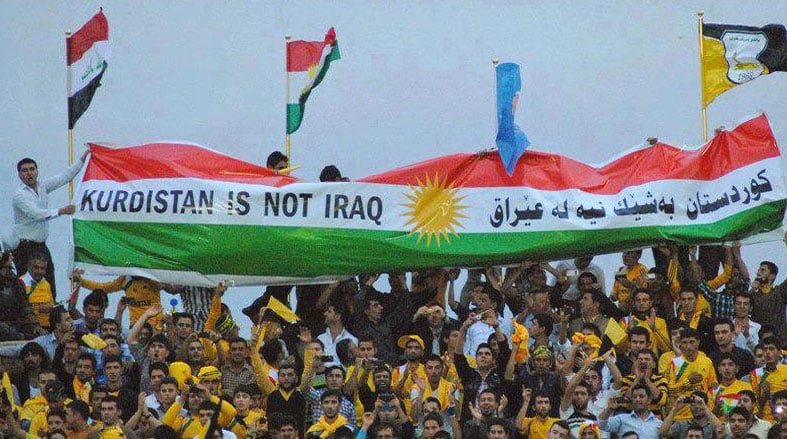


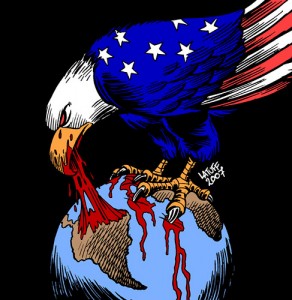
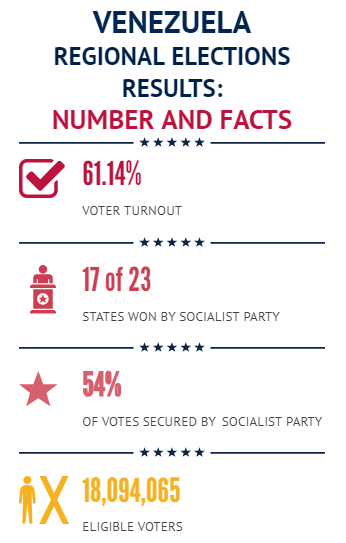


 Unions have been loath to commit the resources needed for an organizing strategy that would mean approaching potentially tens of thousands of workers, working in thousands of small workplaces and then having to negotiate a first collective agreement with cash-strapped employers. Unions just don’t see the benefit to them – even though there is plenty of talk about the injustice of womens’ underpaid and precarious work.
Unions have been loath to commit the resources needed for an organizing strategy that would mean approaching potentially tens of thousands of workers, working in thousands of small workplaces and then having to negotiate a first collective agreement with cash-strapped employers. Unions just don’t see the benefit to them – even though there is plenty of talk about the injustice of womens’ underpaid and precarious work.